

March 2024 NewsletterISSN: 1933-8651
In this issue we present the following articles, news, announcements, and reviews:
|
Articles, Essays, and Reports
News and Announcements
New Books and Exhibits
Book Reviews
|
National Register for Historic Places Grant
for African-American Heritage Sites in Southern Illinois
By Mark Wagner
The Center for Archaeological Investigations (CAI) at Southern Illinois University Carbondale (SIUC) has received a grant from the Illinois State Historic Preservation Office to prepare multiple-property and individual site nomination forms for selected African-American heritage sites in southern Illinois to be added to the National Register for Historic Places (NRHP).
African-American heritage sites are underrepresented on the NRHP in Illinois as a whole and southern Illinois in particular. This project represents a first step in correcting that imbalance. Much of the research will be conducted by George Hunt, an African-American PhD student in History at SIUC.
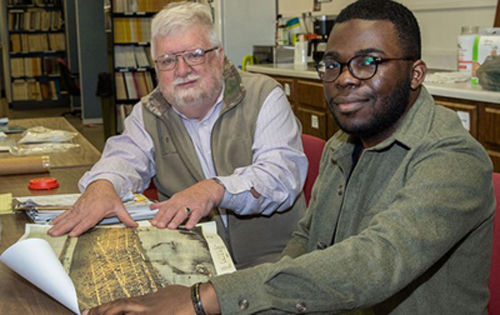
Mark Wagner, professor, SIUC CAI, and George Hunt, a doctoral student in history, look over a copy of an 1867 lithograph of Cairo (Photograph by Russell Bailey, SIUC).
The sites we are researching include a large Civil War contraband camp in Cairo, Illinois, which reportedly housed 5,000 refugees at its peak.
Other sites include: a pre-Civil War freed slave community named Miller Grove in Pope County, Illinois; a settlement in Jackson County, Illinois, that established Union Navy veterans following the Civil War by; and a segregated Civilian Conservation Corps camp named Camp Pomona in Union County that housed Black enrollees.
Research into archival records needed to complete the NRHP forms is being conducted both in Illinois and the National Archives in Washington, D.C. The research at the National Archives has been very productive so far in terms of the Cairo, Illinois, contraband camp, which was administered by the U.S. Army Quartermaster Corps, whose records are now held in the National Archives.
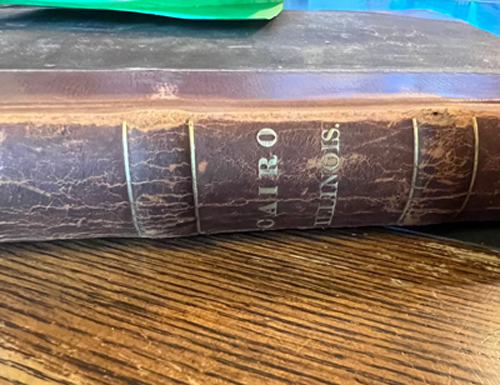
Information regarding the Cairo contraband camp is contained in Union army Quartermaster Corps ledgers like this in the National Archives (Photograph by Mark Wagner).
Additional information includes a Civil War-era map of Cairo, believed to date to 1865, on which the buildings of the Contraband and Freedmen's camp, as well as the Union Quartermaster Corps buildings, are hand-drawn in ink.
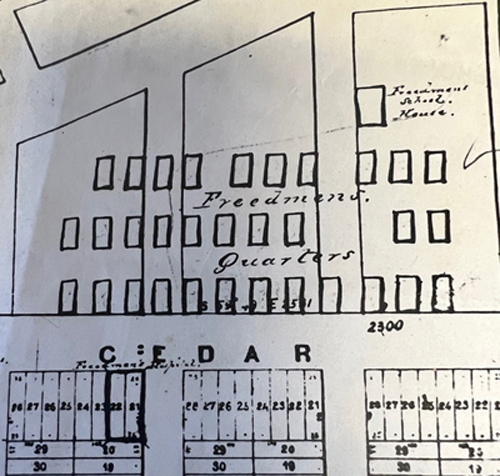
A Civil War map of Cairo, circa 1865, maintained in the Cairo Public Library collections, on which 33 buildings are identified as the "Freedmen's Quarters" and "Freedmen's School House" (Photograph by Mark Wagner).
[Return to table of contents]
Profiles in Practice: William A. White III
By Christopher Fennell
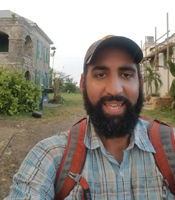
This newsletter feature on "profiles in practice" provides brief overviews of the recent activities of researchers and activists in African diaspora subjects. Please contact Chris Fennell (cfennell@illinois.edu) if you would like to contribute a profile for a future newsletter issue.
Dr. William White III is an archaeologist and associate professor in the Department of Anthropology at the University of California, Berkeley. He has worked in African diaspora archaeology projects for over two decades. White's faculty webpage observes: "When he was four-years-old," he "decided he wanted to either be an astronaut or an archaeologist when he grew up. He decided to follow his dream career of doing archaeology as a teenager when he realized he was an inch too tall to fit into a NASA space suit. . . . Bill finished his Bachelor of Arts in anthropology at Boise State University in 2001 and his Masters at the University of Idaho in 2005. Upon completing his Masters, Bill entered a colorful career in the cultural resource management industry." He later resumed graduate studies and completed is doctoral degree at the University of Arizona in 2017.
In 2004, White served as a teaching assistant and supervising archaeologist in the New Philadelphia Archaeology Project in western Illinois. This multi-year, collaborative, and community-engaged project explored the archaeological evidence of the first town planned in advance and legally founded by African Americans in the United States. White's contributions, along with many others in this multi-disciplinary initiative, led to New Philadelphia being designated as America's 424th National Park in 2022. Over those years White has contributed an expansive body of research and scholarship on African diaspora sites throughout North America and the Caribbean.
White's dissertation project focused on a mixed community along River Street in Boise, Idaho. His 2017 article, "Writ on the Landscape: Racialization, Whiteness, and River Street," Historical Archaeology 51(1): 131-148, presented a fascinating study of this complex neighborhood. White next published a book-length engagement with these subjects in 2023, entitled Segregation Made Them Neighbors: An Archaeology of Racialization in Boise, Idaho, providing a full account of the results of this multi-year project. His studies presented in this article and book are excellent. The book was published through the enhanced peer review process of a collaborative book series sponsored by the Society for Historical Archaeology (SHA) and the University of Nebraska Press.
White's research on the River Street community was formulated as a collaborative, community-engaged, and interdisciplinary project. He worked to uncover the memories of a once-vibrant neighborhood demolished under 1970s urban renewal policies. White observed the ways in which European-American residents of River Street became entangled with racial perceptions of that landscape. He asked whether an elaborated concept of "whiteness" provides a better heuristic than simply positing an intersection of class and race. He found that an "other" identity was assigned to anyone who lived in River Street, a neighborhood that included African Americans, Asian Americans, and poor European Americans. River Street, despite its diversity, was conceptualized as a simplistic contrast that provided the basis against which privileged, white society in Boise defined itself. In turn, the residents of River Street experienced an enhanced level of cohesiveness as neighbors stigmatized equally by outsiders. Cycles of complex intersections of racism and class emerge in such studies. In past episodes spanning centuries, Anglo-American racism embraced different populations of poor European Americans as white. Wealthy and powerful Anglo Americans did so to solidify an alliance of the social, economic, and political interests of those poorer Europeans with their own goals. Class divisions were relaxed in order to strengthen a racial divide and maintain the oppression of African-American and Asian-American interests. In later periods in places like Boise, poor European Americans were reassigned to the other side of the line of racial categories and stigmatized in the same way as the other targets of discrimination.
White similarly presents an excellent overview of myriad concepts in landscape archaeology in his book, and how those intersect with dynamics of racism in societies. He also provides a compelling set of guidelines for ways in which archaeologists can engage in truly collaborative research projects with members of local and descendant communities. White's study presents an excellent analysis based on extensive data from interdisciplinary sources, including numerous oral history accounts, archival evidence, and a thorough compilation of archaeological findings. The study similarly tackles multiple dimensions of cultural dynamics, including economics, social status, politics, religion, foodways, sartorial norms, spatial distributions, gender roles, community norms of respectability, and racial categories. In concluding his 2023 book, White emphasizes the importance of the "project's antiracist archaeological praxis," which "seek[s] to break the structures and narratives at the heart of American racism." He provides vitally important lessons for researchers, practitioners, scholars, and citizens alike.
White's creative approach to analysis was also on display in an otherwise mundane-sounding study published in 2017 on "Applying Risk Management Concepts" to archaeology. This article was published in the Advances in Archaeological Practice series by Cambridge University Press. Field work in archaeology can be dangerous, due to hazards in the built environment and challenges of harsh landscapes and weather conditions. Archaeologists often employ power tools, deep excavation techniques, and protective frameworks when conducting their scientific research. A simple perspective would just look to the safety guidelines available from the analogous activities of the construction industry or the prescriptions published by the Occupational Safety and Health Administration. White brings greater insight and creativity by realizing the dangers presented by young field researchers who are inexperienced in navigating harsh, natural environments and hazardous ruins. He incorporates the additional safety guidelines developed by the outdoor recreation industry to address these hazards in a more effective manner. White's study and recommendations proved prescient as to the increased dangers for archaeology practitioners due to field conditions in a time of climate changes. This danger turned tragic with the death of Kaylen Eileen Gehrke, a participant in an archaeology survey in the Kisatchie National Forest in Louisiana, due to heat exposure in July, 2022. This tragedy was widely reported across national news media. Dr. William Lees, a former president of the SHA, called for renewed discussions of safety measures following her death (link).
White's 2022 study "Remembering Queen Mary," published in the peer-reviewed Journal of African Diaspora Archaeology and Heritage, presents an outstanding, comparative analysis of heritage dynamics in St. Croix and Denmark. St. Croix was shaped as a colony of Denmark and subjected to the hardships of slavery. Large-scale, lucrative sugar plantations relied on enslaved Africans. The colony grew in complex ways, with a notable urban population of free Blacks who participated in a militia and police force, and some of whom owned enslaved laborers themselves. In contrast, Africans in rural plantation settings were typically in bondage. White examines complex histories spanning the period of slavery and post-emancipation following the 1848 end of slavery on the island by Denmark. The post-emancipation period saw exceptionally harsh conditions for many African descendants on St. Croix (Afro-Crucians). They faced grinding poverty as free laborers on the same sugar plantations, paying rents and food expenses and receiving nominal wages. White's study foregrounds the prominent role of women in self-initiatives to improve the living and work conditions. An uprising in 1878 was led by four women, called "queens" of the Afro-Crucian communities, who organized attacks on the sugar plantations.
"Remembering Queen Mary" examines the divergent heritage dynamics in St. Croix and Denmark concerning these histories of the island. White's research combines ethnographic, archival, and archaeological methods. In St. Croix, the history, heritage, and archaeological research by White and others serves a vital role in Afro-Crucians exploring their heritage and pride today. He finds that these research projects, undertaken in collaboration with local residents, provide a forum for healing and reparatory justice for Afro-Crucians struggling with continuing legacies and adverse impacts of past enslavement and colonial expropriation. The more that is learned about the struggles and accomplishments of their ancestors on the island directly enhances the reparatory healing for Afro-Crucians in the present. In contrast, Denmark's society largely seeks to forget their history of colonial enterprise and imposition of slavery on others. Traveling to locations in Denmark and studying the popular discourse there, he finds a concerted forgetting of the past, which he attributes to a form of "white fragility."
This is another example of very creative and insightful conceptual work by White on issues of the dynamics of racism. He transforms a close-scale idea of fragility, which was developed in anti-racism activism and scholarship, and expands the idea into a large-scale, structural avoidance of atonement by a dominant sector of society in Denmark. At the close-scale of anti-racism activism, fragility is an analytic concept to capture the idea that European-American individuals often resist engaging with the subject of racism because they will claim that they did not perpetrate the sins of the past and they are not consciously racist themselves. The challenge is to show them how their lives have been shaped by structural racism that pervades society. White's insight of expanding this analytic concept of fragility to a larger scale is important if one seeks to produce scholarship which can provide lessons applicable in activism to improve societies today. His study shows a broad sector of Danish society which seeks to avoid accountability and atonement for the sins of the past. That finding provides a particular target for the initiatives of future activists, and it is a different target than simply contending that the society has a large population of consciously "white supremacist" citizens. White's scholarship has great potential to significantly advance our understanding of heritage commemoration dynamics and related impacts of structural racism through comparative research in St. Croix and Denmark.
His long-term project focused on St. Croix has also been the subject of co-authored articles with collaborating, co-principal investigators. These works include "Creating Community and Engaging Community" in the peer-reviewed International Journal of Historical Archaeology in 2021 and "Assessing Heritage Resources in St. Croix" in in the peer-reviewed Transforming Anthropology journal (Wiley Press) in 2018. White's broad collaborations have also been the subject of his impressive success in obtaining external grant funding. These include (among others): University of California HBCU Summer Research and Pathways Grants for 2022-2025 and 2019-2022; Nordic Center Research Fellowship, 2022; Aarhus Universitets Forskningsfond grant, 2021-2022; Humanities Research Fellowship, 2021-2022; and Hellman Fellows Fund grant, 2020.
White's engagement with anti-racism scholarship and activism is presented again in his co-authored, 2020 article entitled "Why the Whiteness of Archaeology is a Problem." This article was published in Sapiens, a broadly accessible internet journal of the Wenner-Gren Foundation for Anthropological Research produced by the University of Chicago Press (his article was reportedly viewed by over 25,000 online readers). As an individual of African-American heritage, he brings acute analytic sensibilities to his research, teaching, and service. As the Sapiens article observes "it is the same structural racism that many archaeologists and anthropologists research today that is the reason why archaeologists in the United States and United Kingdom disproportionately are of European ancestry." White has attained an international reputation as a leading voice in this area of anti-racism scholarship and activism. He has delivered invited talks on these subjects, for example, for Durham University and Cambridge University in the United Kingdom, Simon Frasier University in Canada, and Aarhus University and University of Copenhagen in Denmark. He has attained remarkable, international prominence for a scholar so early in his university career. This recognition is also evident in his election to the Board of Directors for the SHA. He is also a founding member of the Society for Black Archaeologists, which has been exceptionally active and successful in anti-racism educational initiatives over the past several years.
The broad range and diverse subjects of White's intellectual curiosity are also illustrated by his 2020 article on "Historical Medicines" in the International Journal of Historical Archaeology. White explores the histories of proprietary and "patent" medicines in nineteenth-century America. White's study does an excellent job of integrating historical and archaeological studies of the surprising resilience of older, simpler forms of medicines in the midst of shifting, national market developments, and then applies cutting-edge laboratory methods to a sample of artifacts.
Such a diversity of scholarly contributions is again evident in White's co-authored book chapter on "Landscapes of Resilience at the Cut Bank Boarding School, Montana," in The Sound of Silence: Indigenous Perspectives on the Historical Archaeology of Colonialism, edited by Tiina Aikas and Anna-Kaisa Salmi (Berghahn Books, 2019). This nuanced study of a boarding school for Native Americans employs interdisciplinary methods of archaeological, oral history, and archival research. Moving beyond a simplistic observation of the dreadful history of such government-supported boarding schools as tools of assimilation, this study illuminates the ways in which members of the Blackfeet population "adapted to harsh conditions . . . maintaining as much of their culture as they could" (p. 156). Archaeological investigations inform Blackfeet people today of the depth of connections that their ancestors experienced across the terrains surrounding them.
White's productivity in his published scholarship is all the more impressive in view of the enormous time commitment he has made to service and teaching. He has appeared in numerous webinars teaching aspects of anti-racism insights and strategies, both on his own and in collaboration with other members of the Society for Black Archaeologists. Those webinars have engaged with thousands of viewers world-wide. Over the past decade White has employed educational and outreach media of numerous blogs, vlogs, e-books, and podcasts to educate the public and practitioners on aspects of anthropology, archaeology, and African-American history (reportedly reaching over 36,000 readers, viewers, and listeners). In addition to traditional courses and field schools, he has spear-headed methods instruction and digital humanities projects for numerous students through his laboratory facilities. White has been equally generous with his time and skills with professional societies, serving on committees and boards of directors. Activities of the SHA engage with an international scale, as do White's initiatives for organizations such as the Danish West Indies Collective.
[Return to table of contents]
International Day of Remembrance of the Victims
of Slavery and the Transatlantic Slave Trade
 United Nations
United Nations
Press Release, March 25, 2024.
"Let Us Redouble Our Efforts to Confront Legacy of Slavery in Our Own Communities, Societies," Says Secretary-General.
UN Secretary-General António Guterres' remarks, delivered by Chef de Cabinet Courtenay Rattray on behalf of the Secretary-General, at the General Assembly event marking the International Day of Remembrance of the Victims of Slavery and the Transatlantic Slave Trade, in New York.
I am honoured to be with you to commemorate the International Day of Remembrance of the Victims of Slavery and the Transatlantic Slave Trade.
Please allow me to read a message from the Secretary-General, marking this important annual commemoration:
"For 400 years, enslaved Africans fought for their freedom, while colonial Powers and others committed horrific crimes against them.
On the International Day of Remembrance of the Victims of Slavery and the Transatlantic Slave Trade, we remember and honour the millions of Africans who were trafficked and enslaved.
Their lives were ruled by terror, as they endured rape, floggings, lynchings and other atrocities and humiliations.
Many of those who organized and ran the transatlantic slave trade amassed huge fortunes. Meanwhile, the enslaved were deprived of education, health care, opportunity and prosperity.
This laid the foundations for a violent discrimination system based on white supremacy that still echoes today.
Descendants of enslaved Africans and people of African descent are still fighting for equal rights and freedoms around the world.
Today and every day, we reject the legacy of this horrific crime against humanity.
We call for reparatory justice frameworks to help overcome generations of exclusion and discrimination.
We appeal for the space and necessary conditions for healing, repair and justice.
And above all, we resolve to work for a world free from racism, discrimination, bigotry and hate.
Together, as we remember the victims of the transatlantic slave trade, let's unite for human rights, dignity and opportunity for all."
On this important day of remembrance, we also recall the courage of generations of enslaved Africans and their descendants who stood against oppression and subjugation.
From the time of the first abductions, to the door of no return in Africa, to the cities and farms where they were forced to work, enslaved Africans resisted their captors, revolted against their masters and worked to escape their bonds.
The resolute resistance of Queen Nanny of the Maroons in my own country, Jamaica, forced the British Empire to the peace table.
In Brazil, the leadership and struggle of Zumbi dos Palmares is celebrated annually as a Day of Black Consciousness.
The skillful diplomacy and military prowess of Queen Nzinga Mbandi of Ndongo and Matamba in present-day Angola thwarted Portugal's colonial ambitions.
In Saint Domingue, in present-day Haiti, Toussaint Louverture's heroism transformed a slave rebellion into a revolutionary movement.
Here in the United States, Harriet Tubman made a death-defying run for freedom and helped others to win their liberation on the Underground Railroad.
And, on a slave ship on the way to the American state of Georgia, a group of Ibo people from what is now Nigeria rose in rebellion and drowned their captors, before tragically committing mass suicide, refusing to give up their dignity and freedom.
This evening, I will attend the opening of a new UN exhibition which tells the story of this tragic event.
The heroic struggles of these and many other leaders inspired generations of activists. But they are not over. Descendants of enslaved Africans and people of African descent around the world are still fighting for their rights and for their freedoms.
The original lie of white supremacy, which animated and justified the horrors of the transatlantic slave trade, the Jim Crow laws and the apartheid system, continues to poison communities and societies.
Today, as we recall centuries of injustice, it is our duty to reject and dismantle racist oppression, end the spread of hatred and lies online, and confront slavery's lasting legacy of marginalization and impoverishment.
We must reverse the consequences of generations of exclusion and discrimination that led to gross inequities in health care, education, and social and economic opportunities — inequities as you know that continue to this day.
In the many countries affected by the transatlantic slave trade, everyone, and all parts of society, have a part to play in this work of healing and repair. From acknowledging and seeking forgiveness for the egregious crimes of the past, to creating mechanisms for redress and rejecting hatred and discrimination in all its forms — all can help to heal the intergenerational trauma and repair fractured and segregated societies.
Today, as we remember the victims of slavery and the transatlantic slave trade, let us redouble our efforts to confront the legacy of slavery in our own communities and societies.
Together, let us resolve to learn the lessons of history and build a more just, a more equal, and a more prosperous world for all."
[Return to table of contents]
St. Helena Urged to Return Remains
of 325 Formerly Enslaved People to Africa
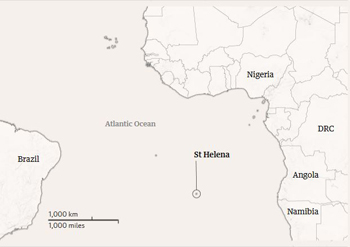 By Haroon Siddique
By Haroon Siddique
The Guardian, March 27, 2024.
British overseas territory may face legal action over alleged failure to honour reburial plan after remains found during airport project.
A British overseas territory is being urged to return the remains of 325 formerly enslaved people to their ancestral kingdoms in Africa, or potentially face legal action.
The remains were excavated in 2008 when an access road to a new airport was being built on the remote South Atlantic Ocean island of St Helena. They were held in storage for 14 years before being reburied.
A master plan was drawn up for a "dignified reburial" and memorialisation and to protect up to 10,000 other remains in the African burial ground in Rupert's Valley from which they were removed, described as "the most significant physical remaining trace of the transatlantics slave trade on Earth."
Despite endorsing the plan, the St Helena government, led by an appointee of the UK Foreign Office, has failed to honour it, according to its co-authors, Annina van Neel and Peggy King Jorde. They cite the lack of a memorial marking the site where the 325 were reburied and the fact that a national conservation area has not been created to protect the original burial ground.
Van Neel, who was the airport project's environment officer when the bones were uncovered, has enlisted the help of State of the African Diaspora (Soad) to repatriate the 325 and prevent further desecration of the site.
The St Helena claim is one of many issued this month by Soad, which is recognised by the African Union, seeking restitution from countries including the UK, institutions and individuals.
[Read this full 2024 article and a related article about the archaeological investigations from our 2009 Newlsetter online >>>].
National Monument Honoring Enslaved
African Americans Opening in Montgomery, Alabama
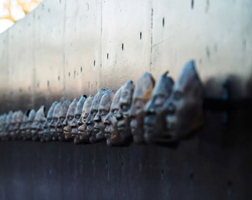 Axios.com, March 23, 2024.
Axios.com, March 23, 2024.
A new monument and sculpture park honoring 10 million enslaved Black people in the United States is opening in Montgomery, Alabama. The Freedom Monument Sculpture Park and National Monument to Freedom will become the closest the U.S. has to a national monument to the victims of enslavement.
It comes as some states in recent years have passed bills limiting the discussion of slavery in public schools.
The Equal Justice Initiative announced the project — which will be part of its Legacy Sites — will open after years of planning. The 17-acre site combines historical artifacts, contemporary art, original research, and first-person narratives to explore the institution of slavery, the lives of enslaved people, and the legacy of slavery in the U.S. The Freedom Monument Sculpture Park will have structures and totems, including 170-year-old dwellings from cotton plantations and bricks made by enslaved people 175 years ago.
The National Monument to Freedom stands 43 feet tall and 155 feet long, and sits at the end of the Sculpture Park. It uses research from the 1870 Census — the first time formerly enslaved Black people were able to formally record a surname — to list over 122,000 surnames that nearly five million Black people adopted at the time.
[Read this full article and a related article by New Yorker online >>>].
[Return to table of contents]
Abby, Harriet, and Benjamin: The Montpelier Naming Project
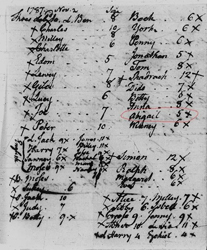 By Marianne Dhenin
By Marianne Dhenin
Saving Places, Feb. 1, 2024.
Montpelier, a sprawling estate in today's Orange County, Virginia, is best known as the home of generations of the Madison family, including Founding Father and fourth President of the United States James Madison and his wife, Dolley. However, over the three generations that the Madison Family lived at Montpelier, beginning with President Madison's grandfather in the early decades of the eighteenth century, approximately 300 enslaved persons also lived on the estate.
After years of research, The Naming Project, a website launched in 2020, has begun to host biographies of these enslaved residents and explanations of how their names and stories have been uncovered in the archives. The project received early input from the Montpelier Descendants Committee, an organization comprised of those who trace ancestry to people once enslaved at Montpelier. The project is led by Senior Research Historian at Montpelier, Hilarie M. Hicks. Since it began, Hicks has published more than 40 biographies. The project will continue until all 300 enslaved persons that researchers have identified have their own biographies.
The Naming Project helps tell a more complete story of the estate, a National Trust Historic Site and National Historic Landmark, first listed on the National Register of Historic Places in 1966.
The Naming Project is part of a longstanding mission at Montpelier to help visitors engage with historical and archaeological research and museum interpretation. "This is an effort to pull back the curtain, look behind it, and see how the sausage gets made at the museum," says Terry Brock, a research associate at Wake Forest University in Winston-Salem, North Carolina, and former assistant director of archaeology at Montpelier.
While immersing visitors in the research process has always been a goal of the staff at Montpelier, The Naming Project takes this work online in a new way. Doing so was, in part, a response to the uncertainties of the COVID-19 pandemic and early pandemic-era restrictions that forced the museum to close its doors to on-site visitors. To engage audiences while the museum was closed to in-person visitors, Montpelier staff began to expand the museum's online presence and offer more virtual opportunities to explore the estate and its exhibitions.
One of Montpelier's first engaging online projects was Unlocking Montpelier, a fundraising effort that used geographic information systems technology to render the estate's main house as a navigable digital map. Donors could make online contributions to unlock the home's virtual doors and receive behind-the-scenes access to people, stories, research, and stewardship.
[Read this full article online >>>].
[Return to table of contents]
Back to Africa Heritage and Archaeology Project
Receives 2024 Mark E. Mack Award for Community Engagement
Congratulations to the "Back to Africa Heritage and Archaeology Project" on receiving the Society for Historical Archaeology's Mark E. Mack Community Engagement Award in January 2024.
The Mark E. Mack Community Engagement Award honors individual researchers or research project teams who exhibit outstanding best practices in community collaboration, engagement, and outreach in their historical archaeology and heritage preservation work. The award commemorates the life and career of Mark E. Mack and encourages diversity in the SHA and our profession by cultivating relationships between archaeologists and stakeholder communities. Mack was well known for his work on the New York African Burial Ground project. He was a professor of anthropology at Howard University and curator of the university's W. Montague Cobb Research Laboratory. Throughout his career, he exemplified many of the qualities we value as best practices in community and stakeholder collaboration. The certificates for these awards were presented at the January 2024 Society for Historical Archaeology conference in Oakland, California.
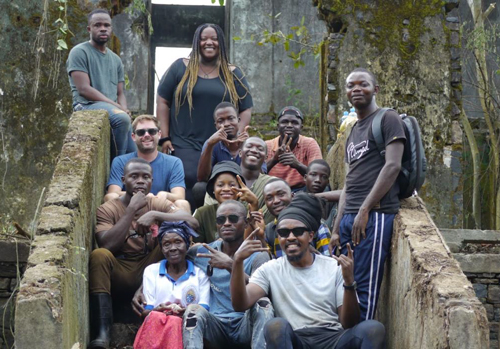
The BAHA team on the stairs of the former Porte family home in the Barbadian-settled township of Crozierville, Liberia, June 2022. Following the home's abandonment and destruction during the war, team members cleared vegetation and excavated units at the home working in close concert with Porte family members in Liberia and abroad. Excavated materials are now held at the National Museum of Liberia (Photograph by Craig Stevens).
From the nomination: "Since 2017, the Back-to-Africa Heritage and Archaeology (BAHA) project has brought together students, scholars, governmental officials, heritage professionals, and community members in Liberia and based in the United States to undertake the first archaeological research conducted in Liberia in roughly 50 years. After many years of brutal Civil War (1989-2003) in Liberia, the BAHA team is the first to investigate coastal sites related to nineteenth-century settlement and their significance on the Liberian landscape today. Co-founded by Dr. Matthew Reilly (City College of New York) Dr. Caree Banton (University of Arkansas), and Craig Stevens (Northwestern University), the BAHA team's interdisciplinary approach foregrounds community engagement to study how settlers envisioned their projects of freedom making and nation building, as well as the complex relationships that emerged between migrants and Indigenous Liberians."
[Return to table of contents]
Journal of African Diaspora Archaeology and Heritage
Vol. 12, Issues 2 & 3 (July, Nov. 2023)
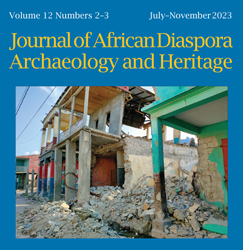 Our July and November issue of the Journal of African Diaspora Archaeology and Heritage is available online, including:
Our July and November issue of the Journal of African Diaspora Archaeology and Heritage is available online, including:
"Renegotiating and Theorizing Heritage in the Context of 'Disaster' in the Caribbean: The Entanglement of Haitian Disaster-Related Histories," by Joseph Sony Jean and Jerry Michel (open access)
https://doi.org/10.1080/21619441.2023.2301153
"Transformation and Resistance: African Diaspora Archaeology in Brazil," by Lucio Menezes Ferreira and Luis Symanski
https://doi.org/10.1080/21619441.2022.2159377
"African Presence in Portugal: People and Things Within Material, Social, and Power Relations," by Tânia Manuel Casimiro, Francisco Curate, and Nathalie Antunes-Ferreira
https://doi.org/10.1080/21619441.2023.2290811
"Excavating Enslavement in the Garden State: Historical Archaeology of an Eighteenth and Nineteenth Century Plantation Near Trenton, New Jersey," by Nicholas Wekselblatt and George M. Leader
https://doi.org/10.1080/21619441.2023.2182345
[Return to table of contents]
Restorative Justice in Heritage Studies & Archaeology

Overview: Restorative justice in heritage and archaeology embraces initiatives for reconciliation of past societal transgressions using processes that are multivocal, dialogic, historically informed, community based, negotiated, and transformative. This book series will present works that promote the active and often unconventional ways that archaeologists, historians, and heritage scholars are contributing to a process of remaking. Our authors work to define and illuminate the best practices for restorative justice in these fields and to identify how practitioners and their collaborators are working to redress, reconcile, and remake contemporary society.
Background: The concept of "restorative justice" has been employed mainly in criminal justice and human rights contexts. For example, restorative justice in the realm of criminal sanctions involves a process of justice other than penalties and imprisonment, and typically entails rehabilitation of offenders through reconciliation with victims and a related, stakeholder community. Such initiatives emerged in the 1970s as ways to address the shortcomings of Western legal systems. New approaches focus on perpetrators of wrongs taking responsibility and acknowledging the harms they created. At the same time, victims of harm have a space to grieve, express their perspectives and stories, seek answers and responses to their needs, and repair relationships.
For example, an archaeological and historical study of past sites of enslavement could provide a focal point for creating new commemorations negotiated among members of local and descendant communities related to those sites. Existing memorials to historical figures who engaged in past oppressive regimes provide similar opportunities for dialog and negotiation to envision new ways to address the context and significance of those figures and the many people who were targets of their oppression. Such restorative justice efforts typically focus on multiple perspectives and modes of reconciliation, rather than a narrow vision of retribution and punishment. Reparation initiatives are often multivocal, layered, multiplex, and visionary in this way.
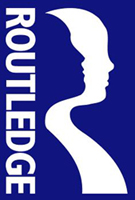
Other examples of such restorative justice projects in archaeology and heritage studies include the current work in Tulsa, Oklahoma to document the 1921 destruction of Black Wall Street and the continuing dynamics of African-American heritage in Tulsa to the present. Elsewhere, archaeologists are collaborating with members of African-American and Indigenous communities to search for missing children. Similar projects search for the remains of the casualties of the Spanish Civil War (1936-1939). Heritage activists also engage with instances of apartheid, cultural destruction through assimilation policies, and genocide in several countries, including work of Truth and Reconciliation Commissions in Canada and South Africa. These examples highlight the bilateral, dialogic, and ongoing process of working towards transformative, meaningful, and enduring justice for aggrieved parties.
Series Editors: Nedra K. Lee, PhD, Department of Anthropology, University of Massachusetts (profile link); Richard Paul Benjamin, PhD, International Slavery Museum and University of Liverpool (profile link); Christopher C. Fennell, PhD, Department of Anthropology, University of Illinois, Urbana-Champaign (profile link).
Learn More: We welcome proposals for single-authored, co-authored, and edited volumes. Interested in proposing a book for this series? Contact one of the series editors: Nedra.Lee@umb.edu, Richard.Benjamin@liverpool.ac.uk, cfennell@illinois.edu. General guidelines for authors are available from Routledge Press (Taylor & Francis) (link). Follow this initiative through our website (link), and on Facebook (link).
[Return to table of contents]
2024 Archaeological Field Schools
Addressing African Diaspora Subjects
The following field school list includes announcements sent to us by the field school directors and others listed on various directories. The field school announcements that follow are presented below in alphabetic order by location.
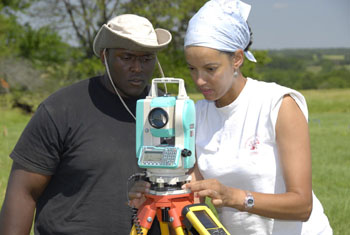
The Kennedy Farm Field School: Archaeology of Abolitionist, Black, and Queer Placemenking. The Kennedy Farm Field School will be located in Sharpsburg, Maryland and run from May 28 through July 5, 2024. Students will be instructed in both archaeological and preservation field methods, including: shovel test pit and unit excavation, archaeological survey and mapping, artifact identification and processing, unit plans, wall profiles, architectural drawing, and more.
Kennedy Farm, once used by abolitionist John Brown to stage his raid on Harpers Ferry, boasts over a century-long period of historical significance. The property was once owned by an African American fraternal organization, commonly known as the Black Elks, who built and operated a popular dance hall along the Chitlin Circuit throughout the 1950s and 60s. Patrons remember seeing iconic black musicians and singers such as James Brown, Tina Turner, B.B. King, Ray Charles, Etta James, Otis Redding, and more. In the 1970s, the property became an all-gay campground and dance venue, known to those who visited as "Elk Ridge Ranch."
All students receive in-state tuition, and transportation will be provided from the University of Maryland, College Park (UMD) campus to the site. The field school is open to both undergraduate and graduate students. It will be cross-listed as HISP319A / HISP619A / ANTH496/696 and satisfy DSSP and DVUP general education requirements at UMD. An optional lab methods course will be offered directly following completion of the field school, from July 8 to July 26. Registration for both courses opens February 20. Please contact Dr. Stefan Woehlke (swoehlke@umd.edu) with any questions.
Archaeology of Chesapeake Landscape and Slavery at Monticello, Virginia. Anthropology 5589. 6 credits. Six-Week Session: June 3 to July 12, 2024. Monticello's Department of Archaeology and the University of Virginia offer a six-week archaeological field school at Monticello. The field school provides six credits through the University of Virginia's College of Arts and Sciences. The Monticello-UVA Field School accepts applications from undergraduate students as well as postgraduates. A current or previous affiliation with UVA is not required to attend.
The Monticello-UVA Field School offers a hands-on introduction to basic excavation, recording, and laboratory techniques in archaeology. The course emphasizes a scientific, multidisciplinary approach to doing landscape archaeology. It also provides the opportunity to contribute to cutting-edge research into the ecological and social dynamics that unfolded on Thomas Jefferson's Monticello Plantation in the eighteenth and early nineteenth centuries. Technical topics covered include survey and excavation strategies as well as the analytical possibilities for ceramics, faunal remains, plant phytoliths and pollen, deposits and the sediments they contain, soils, and spatial distributions of artifacts across sites and larger landscapes.
Learn more at https://www.monticello.org/research-education/for-scholars/archaeology-daacs/archaeological-field-school/.
Summer Field School with Montpelier, Virginia. The 2024 Field School will be held from May 27 through June 28, with two virtual sessions on May 22 and 23. The Montpelier Archaeology Department has hosted field school since 1987. Over the past thirty-seven years, the program has grown to include students from a variety of universities, spanning the US and abroad. The field school is a five-week intensive course designed to give students training in field and laboratory techniques. Students will be introduced to excavation and survey methods, cutting edge archaeological recordation and digital data collection techniques (using ESRI's Field Maps, digital mapping, and mobile photogrammetry), artifact processing and basic curation practices. Students will also be introduced to the principals of Public Archaeology, and will be expected to engage with visitors to the site, members of the descendant community, and online. Students will also be expected to engage in discussions around contemporary museum practice with a focus on community based work and restorative justice.
The 2024 excavation season will focus on the Archaeology of Memorialization, where we will work to define the boundaries of the Montpelier Burial Ground of the Enslaved and build our understanding of how the ancestors of Montpelier's descendant community memorialized their loved ones in this space. We are working under the direction of the Montpelier Descendants Committee (MDC) in all aspects of these surveys and excavations. The continued archaeological surveys and excavations at the Montpelier Burial Ground of the Enslaved will help The Montpelier Descendants Committee build a memorial to honor the legacy of their ancestors.
The archaeological work that students will be involved in is aimed at serving the larger goals of memorialization. The archaeology of memorialization aims to due the following: 1. Understand the extent of the burial ground and location of burials in order to protect those burials and prevent any disturbance of human remains during the landscape restoration process. 2. Explore evidence for how the enslaved and their descendants commemorated and honored that space. 3. Restore the landscape of the burial ground, and honor those buried there. This field school and the excavations associated with memorialization is about understanding the landscape, and will NOT include the excavation of burials or human remains. Protection of human remains is central to this project and the interests of the MDC.
The Montpelier Foundation offers scholarships for African American students attending the Field School. For more details, please e-mail [log in to unmask] and ask about scholarship opportunities for African American students. Scholarship application materials are provided when applying for the Field School!
Learn More about the field school at: https://www.montpelier.org/archaeology/field-schools.
Summer Field School in Historical Archaeology, Thomas Jefferson's Poplar Forest, Virginia. June 3 to July 12, 2024. Thomas Jefferson's Poplar Forest and the University of Virginia are pleased to offer the 33rd annual Summer Field School in Historical Archaeology. The field school provides a foundation in current methods and theories of historical archaeology, and offers a solid introduction to the practical skills of site survey, excavation, recording, and laboratory procedures. Students will also actively participate in our ongoing interpretation of archaeology to the public.
In the summer of 2024, field school participants will excavate sites associated with Poplar Forest's enslaved residents. Our primary focus will be a standing brick quarter, which was built in the 1850s and continued to house African American tenants in the years following emancipation. The program includes weekly readings on topics in historical archaeology; lectures by staff and noted authorities covering such topics as landscape history, plantation life, and nineteenth-century material culture; the archaeology of the African Diaspora in America and beyond; environmental archaeology; professional opportunities in historical archaeology; and the role of public archaeology in our world today. All participants accepted into the field school will receive a scholarship from Poplar Forest.
For questions, contact Eric Proebsting, Director of Archaeology and Landscapes at eric@poplarforest.org, and apply on our website: https://www.poplarforest.org/learn/educational-programs-and-resources/archaeology-field-school/.
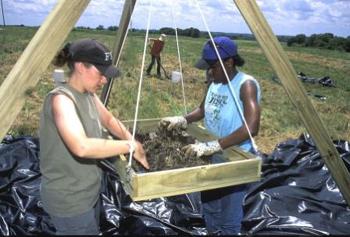
New Book
The Gift: How Objects of Prestige Shaped the Atlantic Slave Trade and Colonialism
By Ana Lucia Araujo
Cambridge University Press
307 pp., ISBN-13 978-1108839297, 2024.
Description from the Publisher:
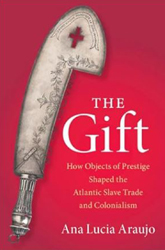 The Gift explores how objects of prestige contributed to cross-cultural exchanges between Africans and Europeans during the Atlantic slave trade. An eighteenth-century silver ceremonial sword, commissioned in the port of La Rochelle by French traders, was offered as a gift to an African commercial agent in the port of Cabinda (Kingdom of Ngoyo), in twenty-first century Angola. Slave traders carried this object from Cabinda to Abomey, the capital of the Kingdom of Dahomey in twenty-first century's Republic of Benin, from where French officers looted the item in the late nineteenth century. Drawing on a rich set of sources in French, English, and Portuguese, as well as artifacts housed in museums across Europe and the Americas, Ana Lucia Araujo illuminates how luxury objects impacted European–African relations, and how these economic, cultural, and social interactions paved the way for the European conquest and colonization of West Africa and West Central Africa.
The Gift explores how objects of prestige contributed to cross-cultural exchanges between Africans and Europeans during the Atlantic slave trade. An eighteenth-century silver ceremonial sword, commissioned in the port of La Rochelle by French traders, was offered as a gift to an African commercial agent in the port of Cabinda (Kingdom of Ngoyo), in twenty-first century Angola. Slave traders carried this object from Cabinda to Abomey, the capital of the Kingdom of Dahomey in twenty-first century's Republic of Benin, from where French officers looted the item in the late nineteenth century. Drawing on a rich set of sources in French, English, and Portuguese, as well as artifacts housed in museums across Europe and the Americas, Ana Lucia Araujo illuminates how luxury objects impacted European–African relations, and how these economic, cultural, and social interactions paved the way for the European conquest and colonization of West Africa and West Central Africa.
[Return to table of contents]
New Book
Materializing the Middle Passage: A Historical Archaeology
of British Slave Shipping, 1680-1807
By Jane Webster
Oxford University Press
544 pp., ISBN-13 978-0199214594, 2024.
Description from the Publisher:
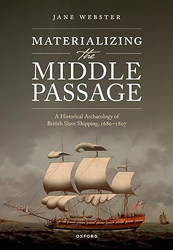 An estimated 2.7 million Africans made an enforced crossing of the Atlantic on British slave ships between c.1680 and 1807--a journey that has become known as the 'Middle Passage.' This book focuses on the slave ship itself. The slave ship is the largest artefact of the Transatlantic slave trade, but because so few examples of wrecked slaving vessels have been located at sea, it is rarely studied by archaeologists. Materializing the Middle Passage: A Historical Archaeology of British Slave Shipping, 1680-1807 argues that there are other ways for archaeologists to materialize the slave ship. It employs a pioneering interdisciplinary methodology combining primary documentary sources, maritime and terrestrial archaeology, paintings, maritime and ethnographic museum collections, and many other sources to 'rebuild' British slaving vessels and to identify changes to them over time.
An estimated 2.7 million Africans made an enforced crossing of the Atlantic on British slave ships between c.1680 and 1807--a journey that has become known as the 'Middle Passage.' This book focuses on the slave ship itself. The slave ship is the largest artefact of the Transatlantic slave trade, but because so few examples of wrecked slaving vessels have been located at sea, it is rarely studied by archaeologists. Materializing the Middle Passage: A Historical Archaeology of British Slave Shipping, 1680-1807 argues that there are other ways for archaeologists to materialize the slave ship. It employs a pioneering interdisciplinary methodology combining primary documentary sources, maritime and terrestrial archaeology, paintings, maritime and ethnographic museum collections, and many other sources to 'rebuild' British slaving vessels and to identify changes to them over time.
The book then goes on to consider the reception of the slave ship and its trade goods in coastal West Africa, and details the range, and uses, of the many African resources (including ivory, gold, and live animals) entering Britain on returning slave ships. The third section of the book focuses on the Middle Passage experiences of both captives and crews and argues that greater attention needs to be paid to the coping mechanisms through which Africans survived, yet also challenged, their captive passage.
Finally, Jane Webster asks why the African Middle Passage experience remains so elusive, even after decades of scholarship dedicated to uncovering it. She considers when, how, and why the crossing was remembered by 'saltwater' captives in the Caribbean and North America. The marriage of words and things attempted in this richly illustrated book is underpinned throughout by a theoretical perspective combining creolization and postcolonial theory, and by a central focus on the materiality of the slave ship and its regimes.
[Return to table of contents]
New Book
Black Majority: Race, Rice, and Rebellion in South Carolina, 1670-1740
By Peter H. Wood
50th Anniversary Edition
W. W. Norton & Company
464 pp., ISBN-13 978-1324066200, 2024.
Description from the Publisher:
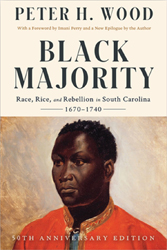 W.W. Norton is proud to announce a new revised and updated edition of Peter H. Wood's groundbreaking history of Blacks in colonial South Carolina, with a foreword by National Book Award winner Imani Perry.
W.W. Norton is proud to announce a new revised and updated edition of Peter H. Wood's groundbreaking history of Blacks in colonial South Carolina, with a foreword by National Book Award winner Imani Perry.
First published in 1974, Black Majority marked a breakthrough in our understanding of early American history. Today, Wood's "insightful and abiding classic" remains more relevant and enlightening than ever. This landmark study chronicles the crucial formative years of North America's wealthiest and most tormented British colony. It explores how West African familiarity with rice determined the Lowcountry economy and how a skilled but enslaved labor force formed its own distinctive language and culture.
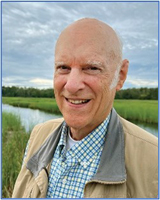 While much recent African American history focuses on the nineteenth and twentieth centuries, Black Majority underscores the significant role that early captive arrivals from Africa played in shaping the direction of American culture. This updated and expanded 50th anniversary edition, challenging a fresh generation with provocative history, features a new epilogue by the author.
While much recent African American history focuses on the nineteenth and twentieth centuries, Black Majority underscores the significant role that early captive arrivals from Africa played in shaping the direction of American culture. This updated and expanded 50th anniversary edition, challenging a fresh generation with provocative history, features a new epilogue by the author.
Peter Wood, a graduate of Harvard and Oxford, taught history at Duke University for more than thirty years. He is the coauthor of Created Equal and Powhatan's Mantle, and he has received the American Historical Association's Distinguished Teaching Award. Wood's books include Strange New Land and Near Andersonville. He lives in Colorado with his wife, Pulitzer Prize-winning historian, Elizabeth A. Fenn (author photograph by Virginia McGee Richards).
[Return to table of contents]
New Exhibit
Museum of the African Diaspora
San Francisco, California
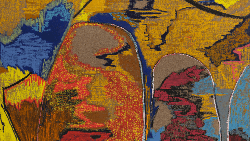 Description from the Museum:
Description from the Museum:
This spring, the Museum of the African Diaspora unveils an exciting lineup of exhibitions.
A new body of work by acclaimed British visual artist and painter Rachel Jones. Curated by Erin Jenoa Gilbert, this exhibition premiers a new series of vivid oil pastel landscapes which continue Jones' ongoing exploration into Black interiority and personhood.
Unruly Navigations, curated by Key Jo Lee, MoAD's inaugural Chief of Curatorial Affairs and Public Programs, testifies to the urgent, disorderly, rebellious, and nonlinear movements of people, cultures, ideas, religions, and aesthetics that define diaspora.
The latest in MoAD's Emerging Artists Program series, Mary Graham's solo exhibition Value Test: Brown Paper, a reflection on colorism, classism, and power, and their roots in white supremacy.
[Return to table of contents]
Book Review
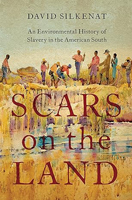
David Silkenat. Scars on the Land: An Environmental History of Slavery in the American South. New York: Oxford University Press, 2022. 272 pp. (cloth), ISBN 978-0-19-756422-6.
H-Net Book Review, published by H-Environment, https://networks.h-net.org/h-environment (February, 2024).
Reviewed for H-Environment by Chris Blakley (Occidental College).
Slavery dispossessed people of African descent of their bodies as the peculiar institution exhausted the soil and remade the topography of the American landscape. David Silkenat's environmental history of slavery in the American South from the colonial period through the Civil War era surveys the "complex interplay" between slavery as an institution and its effect on ecosystems. Expanding on the foundational scholarship of historians, including Avery Craven, Mart Stewart, David Cecelski, and Lorena Walsh, Silkenat puts forward that slaveholders fundamentally saw the American "landscape as disposable" and that "slavery laid waste to fragile ecosystems," such as longleaf pine forests, mountain valleys, river deltas, and grasslands (p. 1). The book plumbs a diverse archival corpus that includes the Works Progress Administration Slave Narrative Collection; the private papers of slaveholders like Edmund Ruffin; the autobiographical narratives of formerly enslaved people, such as William J. Anderson, Charles Ball, and Octavia Victoria Rogers Albert; and travel accounts by authors like Frederick Law Olmsted and Frances Anne Kemble. In addition to these primary materials, Silkenat has immersed himself in the secondary literature of the archaeology of slave plantations and mines. Scars on the Land takes a thematic approach to its organization and is divided into seven chapters that explore diverse kinds of human-environmental relations between the late eighteenth century until the second half of the nineteenth century.
Soil depletion and erosion were endemic to the political ecology of slavery. In the first chapter, Silkenat shows that slaveholders saw land as a "disposable commodity" and that tobacco monocropping rapidly leached nitrogen, phosphorus, calcium, and potassium from the topsoil (p. 11). Monoculture exposed plants to root rot and fungi and gullied the landscape of the Tidewater Chesapeake. In the 1840s and 1850s, enslaved people manured plantations with guano imported from the Chincha Islands of Peru, yet dunging did little to replenish worn-out fields. In his discussion of the Georgia gold rush, Silkenat highlights how enslaved people navigated hazardous tunnels and mercury exposure while mining Appalachian hillsides. Given the comparatively low level of oversight, some enslaved miners stole gold dust concealed in their clothing after leaving these mines.
Wild and domesticated animals made up a "complex zoological framework for slavery" across the American landscape, as Silkenat illustrates in the second chapter (p. 32). Enslaved people labored alongside livestock animals and hunted and fished beyond the range of their enslavers to support their meager rations. Hunting afforded opportunities to study landscapes with future fugitivity in mind and to learn to avoid venomous snakes and other dangerous predators. Furthermore, enslaved people thought seriously about the dehumanizing effects of slavery, including being compared "like cattle" or being beaten "like a dog" (p. 55).
Deforestation for pine tapping and clearcutting by enslaved lumbermen transformed ecosystems, the subject of the third chapter. Timbering and lumbering supplied the cabinetmaking and shipbuilding industries with hardwood produced by slaves in the Carolinas. Like soil exhaustion, timbering eroded landscapes and riverine environments by uprooting tree rhizomes. Lumbering also supplied ironworks with charcoal fuel made from pine and oak. Lumberjacking and the knowledge gained from forest work enabled enslaved people to construct "hush harbors," clandestine meeting places covered with brush that the enslaved used as gathering spaces for worship, meditation, and discussion (p. 76).
Slaveholders sought control over hydropower and riverine environments to expand slavery's frontiers in the antebellum period. Levee construction on the Mississippi delta came from enslaved "riparian proprietors" provided to the state by slaveholders (p. 94). Building on the research of Kevin Dawson (Undercurrents of Power: Aquatic Culture in the African Diaspora [2018]) and Julius S. Scott (The Common Wind: Afro-American Currents in the Age of the Haitian Revolution [2020]), Silkenat adds in the fourth chapter how enslaved maritime workers joined a "greater Black Atlantic" through communication networks that reached far beyond their enslaver's surveillance (p. 101).
Storms and periods of intense heat and cold buffeted African American communities under slavery. Race science, as discussed in chapter 5, buttressed the forced labor of slaves in sweltering temperatures, as physicians like Samuel Henry Dickson taught that people of African descent were healthiest "under the hot sun of the South" (p. 115). By contrast, enslaved people spoke out against heatstroke, dehydration, and the dangerous nature of working under excessive heat conditions to plantation visitors. Silkenat adds to the study of race science and slavery by focusing on the experimentation of enslaved people by Thomas Hamilton, a physician and planter. Hamilton tested ideas about Black invulnerability to heat by exposing slaves to intense heat in covered pits in an effort to produce a remedy for heatstroke (p. 117).
Enslaved people weaponized swamps and mountain hideouts as sites of marronage. Silkenat discusses in the sixth chapter the uses of swamps throughout the South, with a particular focus on the Great Dismal Swamp spanning North Carolina and Virginia. Efforts to drain the swamp, including the formation of the Dismal Swamp Company, are rightfully framed here as part of a wider campaign against the freedom of fugitive and free Black communities led by slaveholders. A final chapter turns to the lives of fugitive communities during the Civil War. Silkenat stresses how the war itself is best understood as an effort to expand the ecological frontiers of slavery and sheds light on how Black scouts and pioneers secured the Union's victory by providing critical environmental knowledge on the frontlines. In the conclusion, Silkenat raises the hopes of thinkers like Frederick Douglass for a "new kind of Black ecology" that could have flourished during Reconstruction (p. 171). Douglass and others hoped for a new revitalization of the land by small-scale Black farmers, yet sharecropping and Jim Crow undercut these environmental visions.
Scars on the Land is a remarkable achievement of political ecological analysis, and teacher-scholars will find the book excellent for courses on African American and environmental history. One critique is Silkenat's tendency—with the exception of a citation to the work of Tony C. Perry—to downplay the highly influential literature on the Little Ice Age and climate history developed by scholars like Sam White (A Cold Welcome: The Little Ice Age and Europe's Encounter with North America [2017]). Historians and literary critics—including Jason Hauser, Joe T. Carson, Cristin Ellis, and Mary Kuhn—have profitably brought in methods and questions from studies of the Little Ice Age and climate change to interpret the expansion of slavery as well as Black environmental thought in this period.[1] Moreover, one wonders to what extent the continuation of West African ideas about materials like iron or metallurgy played a role in the histories of mining and iron plantations Silkenat discusses, which has been a topic of past and recent debate and discourse in the scholarship on the African diaspora.[2] Nevertheless, this book is an outstanding contribution to the environmental history of slavery and African American environmental studies.
Notes
[1]. Jason Hauser, "'Scarce Fit for Anything but Slaves and Brutes': Climate in the Old Southwest, 1798-1855," Alabama Review 70, no. 2 (2017): 112-25; Joe T. Carson, "Anthropocene Historicity: Charles Chesnutt and the Politics of Race and Timber," Studies in the Novel 53, no. 4 (2021): 347-67; Cristin Ellis, "Amoral Abolitionism: Frederick Douglass and the Environmental Case against Slavery," American Literature 86, no. 2 (2014): 275-303; and Mary Kuhn, "Chesnutt, Turpentine, and the Political Ecology of White Supremacy," PMLA 136, no. 1 (2021): 39-54.
[2]. Candice L. Goucher, "Iron Is Iron 'til It Is Rust: Trade and Ecology in the Decline of West African Iron-Smelting," Journal of African History 22, no. 2 (1981): 179-89; Chris Evans and Göran Rydén, "'Voyage Iron': An Atlantic Slave Trade Currency, Its European Origins, and West African Impact," Past and Present 239, no. 1 (2018): 41-70; Patrick R. McNaughton, The Mande Blacksmiths: Knowledge, Power, and Art in West Africa (Bloomington: Indiana University Press, 1988); and Jenny Bulstrode, "Black Metallurgists and the Making of the Industrial Revolution," History and Technology (2023): 1-41.
[Citation: Chris Blakley. Review of Silkenat, David, Scars on the Land: An Environmental History of Slavery in the American South. H-Environment, H-Net Reviews. February, 2024. This work is licensed under a Creative Commons Attribution-Noncommercial-No Derivative Works 3.0 United States License. H-Net permits the redistribution and reprinting of this work for nonprofit, educational purposes.]
[Return to table of contents]

©2024 African Diaspora Archaeology Network
Copyright and all rights reserved by
individual authors for each article.
Please send comments, suggestions,
or questions to the editor
Last updated: March 27, 2024
Text only menuSearch
|



